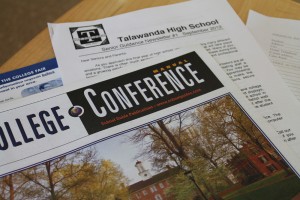Applying to College is More than just Pen and Paper
The time is here for seniors to begin the application process for the colleges of their choice.
The first step in the application process is deciding which colleges to apply to. It is recommended that students apply to multiple universities in case one doesn’t accept them. Backup plans are essential to the application process.
Matt Smith, one of Talawanda’s guidance counselors, recommends students to limit their selection to about five colleges. “We have online tools to help you narrow down your search based on factors like price, majors, and those important details that can make or break a college,” he said.
Next, it is encouraged to go on a college visit before you decide to apply. The visit will give you a feel on the school, and give you a sense of if you will or will not like the campus.
“THS lets students miss school to visit up to three different colleges,” Smith said. “If you haven’t visited, you shouldn’t apply.”
Then, students should ask at least two people (one teacher and one guidance counselor) to write a letter of recommendation. Almost all universities require students to have at least one of these letters. When asking someone to write a letter, students should fill out a personal data worksheet located in the guidance office. Give the person around a month or more to write the letter. Afterwards, you should make sure to write a sincere thank you to the respective writers.
Students also need to write an essay. Some colleges have certain requirements for their essays so be sure to check the college’s website before writing the essay. Most senior english teachers advise that an essay should be no longer than 500 words.
The next step is to fill out the application that will fit the college you’re applying to. This information is on that college’s website. Most colleges accept the common application, but not all do.
Scholarships are worth taking the time to apply. The senior newsletter includes more and more information about various financial aid and scholarship opportunities throughout the year. There are paper copies in the guidance office and an online version available at Talawanda’s guidance page.
Online resources like fastweb.com can provide students with opprotunities for national-level scholarhips. “Think of it like a part time job,” said Smith. “The more hours you put into it, the more money you’re going to get.”
Finally, don’t be afraid to ask for help.
“Don’t be afraid to ask questions,” Smith continued. “I never asked my counselor anything when I was a student because I thought I already knew everything. But, really, I didn’t, and I could have really used that assistance.”




I write the best college recommendations–just saying be nice and smart in my classes and I’ll hook you up.